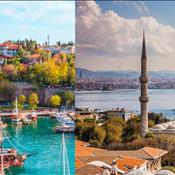
Turkey is one of the most diverse and beautiful countries in the world. There are many attractions to visit in Turkey during winter, including ancient ruins, stunning mountain scenery, and lovely coastal towns.
And with one of the most famous tourist destination in Turkey is Istanbul. This historic city is home to some of the most impressive architecture in the world, including the Blue Mosque and Hagia Sophia. Visitors can also explore a wealth of markets and restaurants, or take a boat cruise down the Bosphorus Strait.
Another popular destination in Turkey is Cappadocia. This area is famous for its unique landscape of rock formations and underground caves. Visitors can explore this landscape on foot or by horseback, or take a hot air balloon ride for aerial views of the region.
The Turkish coast is also a popular destination in winter. The towns of Bodrum, Antalya, and Fethiye are all known for their beautiful beaches, turquoise waters, and charming old towns. These towns are also home to a variety of activities such as sailing, windsurfing, and paragliding.
Though it’s a wonderful idea to visit Turkey in Winter, still there are some important factors to keep in mind. Weather in Turkey during winter can be a bit of a challenge. There is always a chance that it will rain, snow or sleet. This can make getting around difficult, especially if you are not used to the weather conditions. In addition, the cold temperatures can be uncomfortable for many people. However, if you are prepared for the weather and take the necessary precautions, you can still enjoy your time in Turkey during winter.
Turkey has a temperate climate with hot, dry summers and cold, wet winters. The coastal areas are milder in winter than the inland regions. January is the coldest month of the year, with temperatures ranging from 3°C to 12°C in the west and 9°C to 17°C in the east.(We offer International Tour Packages in cheap prices.) The average rainfall ranges from 400 mm in the west to 1,000 mm in the east. Snowfall occurs occasionally in the eastern Black Sea region and more frequently in the highlands of central and eastern Anatolia.
;More Travel News
-
 20-Mar-2023PIA now gives flights details on Whatsapp
20-Mar-2023PIA now gives flights details on Whatsapp -
 07-Jul-2025Sweden to Restart Visa Services from Pakistan Soon
07-Jul-2025Sweden to Restart Visa Services from Pakistan Soon -
 23-May-2025Revolutionizing Connectivity for Pilgrims: eSIM Activation in Saudi Arabia for Hajj
23-May-2025Revolutionizing Connectivity for Pilgrims: eSIM Activation in Saudi Arabia for Hajj -
 28-Mar-2025Record Number of Pilgrims Expected for Hajj 2025
28-Mar-2025Record Number of Pilgrims Expected for Hajj 2025 -
 03-Sep-2025Schengen Visa Chaos Leaves Travelers Stranded: Appointment Delays Spark Frustration
03-Sep-2025Schengen Visa Chaos Leaves Travelers Stranded: Appointment Delays Spark Frustration -
 06-Apr-2025Hajj 2025 Schedule Announced: Government Hajj Flights Start May 28
06-Apr-2025Hajj 2025 Schedule Announced: Government Hajj Flights Start May 28 -
 05-Jun-2023Top 10 places to visit in Turkey this summer of 2023
05-Jun-2023Top 10 places to visit in Turkey this summer of 2023 -
 08-Jun-2022PIA Resumes Commercial Operations for China
08-Jun-2022PIA Resumes Commercial Operations for China -
 04-Sep-2025Have a Safe Flight Meaning in Urdu | Wishes & Quotes for Safe Travels
04-Sep-2025Have a Safe Flight Meaning in Urdu | Wishes & Quotes for Safe Travels -
 08-May-2025Nationwide Airports Fully Operational: PAA Reassures Air Travel Safety Amidst Regional Dynamics
08-May-2025Nationwide Airports Fully Operational: PAA Reassures Air Travel Safety Amidst Regional Dynamics -
 14-Oct-2025How to Stay Focused and Peaceful During Umrah
14-Oct-2025How to Stay Focused and Peaceful During Umrah -
 24-Apr-2025Pakistan’s First Electricity-Producing Road Set to Launch in Lahore
24-Apr-2025Pakistan’s First Electricity-Producing Road Set to Launch in Lahore
